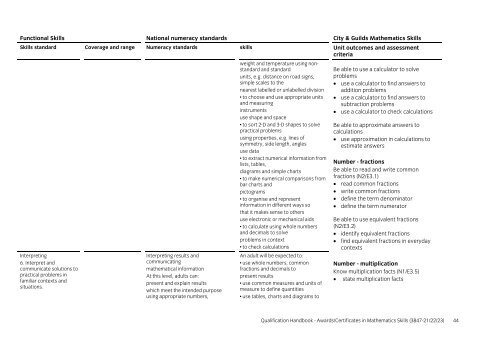Awards/certificates in mathematics skills (3847-21/22 ... - City & Guilds
Awards/certificates in mathematics skills (3847-21/22 ... - City & Guilds
Awards/certificates in mathematics skills (3847-21/22 ... - City & Guilds
Create successful ePaper yourself
Turn your PDF publications into a flip-book with our unique Google optimized e-Paper software.
Functional Skills National numeracy standards <strong>City</strong> & <strong>Guilds</strong> Mathematics Skills<br />
Skills standard Coverage and range Numeracy standards <strong>skills</strong> Unit outcomes and assessment<br />
criteria<br />
Interpret<strong>in</strong>g<br />
6. Interpret and<br />
communicate solutions to<br />
practical problems <strong>in</strong><br />
familiar contexts and<br />
situations.<br />
Interpret<strong>in</strong>g results and<br />
communicat<strong>in</strong>g<br />
mathematical <strong>in</strong>formation<br />
At this level, adults can:<br />
present and expla<strong>in</strong> results<br />
which meet the <strong>in</strong>tended purpose<br />
us<strong>in</strong>g appropriate numbers,<br />
weight and temperature us<strong>in</strong>g nonstandard<br />
and standard<br />
units, e.g. distance on road signs,<br />
simple scales to the<br />
nearest labelled or unlabelled division<br />
• to choose and use appropriate units<br />
and measur<strong>in</strong>g<br />
<strong>in</strong>struments<br />
use shape and space<br />
• to sort 2-D and 3-D shapes to solve<br />
practical problems<br />
us<strong>in</strong>g properties, e.g. l<strong>in</strong>es of<br />
symmetry, side length, angles<br />
use data<br />
• to extract numerical <strong>in</strong>formation from<br />
lists, tables,<br />
diagrams and simple charts<br />
• to make numerical comparisons from<br />
bar charts and<br />
pictograms<br />
• to organise and represent<br />
<strong>in</strong>formation <strong>in</strong> different ways so<br />
that it makes sense to others<br />
use electronic or mechanical aids<br />
• to calculate us<strong>in</strong>g whole numbers<br />
and decimals to solve<br />
problems <strong>in</strong> context<br />
• to check calculations<br />
An adult will be expected to:<br />
• use whole numbers, common<br />
fractions and decimals to<br />
present results<br />
• use common measures and units of<br />
measure to def<strong>in</strong>e quantities<br />
• use tables, charts and diagrams to<br />
Be able to use a calculator to solve<br />
problems<br />
• use a calculator to f<strong>in</strong>d answers to<br />
addition problems<br />
• use a calculator to f<strong>in</strong>d answers to<br />
subtraction problems<br />
• use a calculator to check calculations<br />
Be able to approximate answers to<br />
calculations<br />
• use approximation <strong>in</strong> calculations to<br />
estimate answers<br />
Number - fractions<br />
Be able to read and write common<br />
fractions (N2/E3.1)<br />
• read common fractions<br />
• write common fractions<br />
• def<strong>in</strong>e the term denom<strong>in</strong>ator<br />
• def<strong>in</strong>e the term numerator<br />
Be able to use equivalent fractions<br />
(N2/E3.2)<br />
• identify equivalent fractions<br />
• f<strong>in</strong>d equivalent fractions <strong>in</strong> everyday<br />
contexts<br />
Number - multiplication<br />
Know multiplication facts (N1/E3.5)<br />
• state multiplication facts<br />
Qualification Handbook - <strong>Awards</strong>/Certificates <strong>in</strong> Mathematics Skills (<strong>3847</strong>-<strong>21</strong>/<strong>22</strong>/23) 44
















